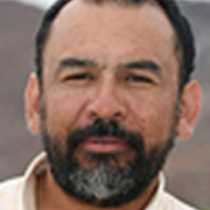Los Islotes & Bonanza Bay, on Espiritu Santo Island
For part of the week we waited for this day to come: the visit to Los Islotes (literally “The Islets”), the site of one of the less than a dozen breeding colonies of the California sea lion in the Sea of Cortes. From all corners of our ship, the National Geographic Sea Bird, we heard the loud barking of the immature males “practicing” to impress each other (like the adults do), as well as the little one-year-old pups’ voices that sounded like lambs, as we approached the place. We also smelled the guano that completely covers the rocks as a gigantic snow carpet.
Right after lunch we conducted Zodiac cruises around these magnificent islets composed of highly weathered and eroded red-and-pink colored volcanic tuff. Guilds of young sea lions immediately surrounded and inspected our boats, and some even tried to get on by jumping out of the water and into the sides of the Zodiacs. As we got closer to the rookery, we observed the big males just sleeping on big boulders, and the females, many of them pregnant, just opening an eye and watching us with the confidence of a dog.
Apart from the sea lions, we observed crowds of different bird species, like brown boobies, brown pelicans and magnificent frigate birds perched on the cliffs, preening themselves, or soaring above on the thermals. Many blue-footed boobies were busy in their courtship rituals, or actually constructing nests. A single great blue heron was seen on a nest built right above a cholla cactus that grew on one flatter slope. Dozens of the endemic yellow-footed gulls patrolled around for an opportunistic snack. When the Zodiac cruises finished, most of us snorkeled among the sea lions, and discovered a wonderful and unexpected living world under the quiet surface of the water.
For the afternoon activities we visited the southeastern most tip of Espiritu Santo-Partida Sur islands, a location known as Bahia Bonanza. An extensive and beautiful whitish, finely-grained beach awaited us. The guests and naturalists that walked along the beach found many interesting dead creatures washed up by the low-energy sea currents, like porcupine fishes, moray eels, pieces of coral, trigger fishes, and so on. A group of birders and hikers explored the low-lying open area behind the shore. Among the creatures seen were native birds (verdins, ash-throated flycatchers, black-throated sparrows) and endemic black jackrabbits running away from us. They tried to hide behind patches of dense vegetation composed of wild plum, jojoba, lomboy, slipper plant or some other representatives of the Sonoran Desert flora. A relaxing kayaking took place also.
There was not a better way to finish our marvelous voyage Among the Gray Whales and the Gulf of California.
For part of the week we waited for this day to come: the visit to Los Islotes (literally “The Islets”), the site of one of the less than a dozen breeding colonies of the California sea lion in the Sea of Cortes. From all corners of our ship, the National Geographic Sea Bird, we heard the loud barking of the immature males “practicing” to impress each other (like the adults do), as well as the little one-year-old pups’ voices that sounded like lambs, as we approached the place. We also smelled the guano that completely covers the rocks as a gigantic snow carpet.
Right after lunch we conducted Zodiac cruises around these magnificent islets composed of highly weathered and eroded red-and-pink colored volcanic tuff. Guilds of young sea lions immediately surrounded and inspected our boats, and some even tried to get on by jumping out of the water and into the sides of the Zodiacs. As we got closer to the rookery, we observed the big males just sleeping on big boulders, and the females, many of them pregnant, just opening an eye and watching us with the confidence of a dog.
Apart from the sea lions, we observed crowds of different bird species, like brown boobies, brown pelicans and magnificent frigate birds perched on the cliffs, preening themselves, or soaring above on the thermals. Many blue-footed boobies were busy in their courtship rituals, or actually constructing nests. A single great blue heron was seen on a nest built right above a cholla cactus that grew on one flatter slope. Dozens of the endemic yellow-footed gulls patrolled around for an opportunistic snack. When the Zodiac cruises finished, most of us snorkeled among the sea lions, and discovered a wonderful and unexpected living world under the quiet surface of the water.
For the afternoon activities we visited the southeastern most tip of Espiritu Santo-Partida Sur islands, a location known as Bahia Bonanza. An extensive and beautiful whitish, finely-grained beach awaited us. The guests and naturalists that walked along the beach found many interesting dead creatures washed up by the low-energy sea currents, like porcupine fishes, moray eels, pieces of coral, trigger fishes, and so on. A group of birders and hikers explored the low-lying open area behind the shore. Among the creatures seen were native birds (verdins, ash-throated flycatchers, black-throated sparrows) and endemic black jackrabbits running away from us. They tried to hide behind patches of dense vegetation composed of wild plum, jojoba, lomboy, slipper plant or some other representatives of the Sonoran Desert flora. A relaxing kayaking took place also.
There was not a better way to finish our marvelous voyage Among the Gray Whales and the Gulf of California.



